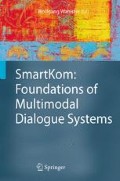Summary
We provide a formal description of the fundamental nonmonotonic operation used for discourse modeling. Our algorithm—overlay—consists of a default unification algorithm together with an elaborate scoring functionality. In addition to motivation and highlighting examples from the running system, we give some future directions.
Access this chapter
Tax calculation will be finalised at checkout
Purchases are for personal use only
Preview
Unable to display preview. Download preview PDF.
References
J. Alexandersson and T. Becker. Overlay as the Basic Operation for Discourse Processing in a Multimodal Dialogue System. In: Workshop Notes of the IJCAI-01 Workshop on “Knowledge and Reasoning in Practical Dialogue Systems”, Seattle, WA, August 2001.
J. Alexandersson and T. Becker. The Formal Foundations Underlying Overlay. In: Proc. 5th Int. Workshop on Computational Semantics (IWCS-5), pp. 22–36, Tilburg, The Netherlands, February 2003.
J. Alexandersson and T. Becker. Default Unification for Discourse Modelling. In: H. Bunt and R. Muskens (eds.), Computing Meaning, vol. 3, Dordrecht, The Netherlands, 2004. Kluwer Academic.
J. Alexandersson, T. Becker, and N. Pfleger. Scoring for Overlay Based on Informational Distance. In: 7. Konferenz zur Verarbeitung natürlicher Sprache KONVENS-04, Vienna, Austria, September–October 2004.
J. Alexandersson and N. Pfleger. Discourse Modeling, 2006. In this volume.
G. Antoniou. A Tutorial on Default Logics. ACM Computing Surveys (CSUR) Archive, 31(4):337–359, December 1999.
G. Bouma. Defaults in Unification Grammar. In: Proc. 28nd Annual Meeting of the Association for Computational Linguistics, pp. 165–172, University of Pittsburgh, PA, 6–9 June 1990.
J. Calder. Typed Unification for Natural Language Processing. In: T. Briscoe, V. de Paiva, and A. Copestake (eds.), Inheritance, Defaults, and the Lexicon, pp. 13–37, Cambridge, UK, 1993. Cambridge University Press.
B. Carpenter. The Logic of Typed Feature Structures. Cambridge University Press, Cambridge, UK, 1992.
B. Carpenter. Skeptical and Credulous Default Unification With Applications to Templates and Inheritance. In: T. Briscoe, V. de Paiva, and A. Copestake (eds.), Inheritance, Defaults, and the Lexicon, pp. 13–37, Cambridge, CA, 1993. Cambridge University Press.
A. Copestake. The Representation of Lexical Semantic Information. PhD thesis, University of Sussex, 1993.
F. Fouvry. Constraint Relaxation with Weighted Feature Structures. In: Int. Workshop on Parsing Technologies-IWPT’03, pp. 103–114, Nancy, France, April 2003.
C. Grover, C. Brew, S. Manandhar, and M. Moens. Priority Union and Generalization in Discourse Grammars. In: Proc. 32nd Annual Meeting of the Association for Computational Linguistics, pp. 17–24, Las Cruces, NM, 1994. Association for Computational Linguistics.
I. Gurevych, R. Porzel, and R. Malaka. Modeling Domain Knowledge: Know-How and Know-What, 2006. In this volume.
I. Horrocks. The FaCT System. In: Automated Reasoning With Analytic Tableaux and Related Methods: Int. Conf. Tableaux’98, pp. 307–312, Oisterwijk, The Netherlands, 1998a.
I. Horrocks. Using an Expressive Description Logic: FaCT Or Fiction? In: Principles of Knowledge Representation and Reasoning: Proc. 6th Int. Conf. (KR’98), pp. 636–647, San Francisco, California, 1998b.
O. Imaichi and Y. Matsumoto. Integration of Syntactic, Semantic and Contextual Information in Processing Grammatically Ill-Formed Inputs. In: Proc. 14th IJCAI, pp. 1435–1440, Montréal, Canada, 1995.
R.M. Kaplan. Three Seductions of Computational Psycholinguistics. In: P. Whitelock, H. Somers, P. Bennett, R. Johnson, and M. McGee Wood (eds.), Linguistic Theory and Computer Applications, pp. 149–188, London, UK, 1987. Academic Press.
L. Karttunen. D-PATR: A Development Environment for Unification-Based Grammars. In: Proc. 11th COLING, pp. 25–29, Bonn, Germany, August 1986. Institut für angewandte Kommunikations-und Sprachforschung e.V. (IKS).
H.U. Krieger. TDL — A Type Description Language for Constraint-Based Grammars. Foundations, Implementation, and Applications. PhD thesis, Universität des Saarlandes, Department of Computer Science, september 1995.
A. Lascarides, T. Briscoe, N. Asher, and A. Copestake. Order Independent and Persistent Typed Default Unification. Linguistics and Philosophy, 19(1):1–89, 1996. Revised version of ACQUILEX II WP NO. 40.
M. Minsky. A Framework for Representing Knowledge. In: P. Winston (ed.), The Psychology of Computer Vision, pp. 211–277, New York, 1975. McGraw-Hill.
N. Pfleger, J. Alexandersson, and T. Becker. Scoring Functions for Overlay and Their Application in Discourse Processing. In: Proc. KONVENS 2002, pp. 139–146, Saarbruecken, Germany, September–October 2002.
H. Tomabechi. Quasi-Destructive Graph Unifications. In: Proc. 29th ACL, pp. 315–322, Berkeley, CA, 1991.
D. Touretzky. The Mathematics of Inheritance Systems. Morgan Kaufmann, San Francisco, CA, 1986.
A. Villavicencio. Representing a System of Lexical Types Using Default Unication. In: Proc. 9th Conf. of the European Chapter of the Association for Computational Linguistics (EACL’95), Bergen, Norway, 1999.
Author information
Authors and Affiliations
Editor information
Editors and Affiliations
Rights and permissions
Copyright information
© 2006 Springer-Verlag Berlin Heidelberg
About this chapter
Cite this chapter
Alexandersson, J., Becker, T., Pfleger, N. (2006). Overlay: The Basic Operation for Discourse Processing. In: Wahlster, W. (eds) SmartKom: Foundations of Multimodal Dialogue Systems. Cognitive Technologies. Springer, Berlin, Heidelberg . https://doi.org/10.1007/3-540-36678-4_17
Download citation
DOI: https://doi.org/10.1007/3-540-36678-4_17
Publisher Name: Springer, Berlin, Heidelberg
Print ISBN: 978-3-540-23732-7
Online ISBN: 978-3-540-36678-2
eBook Packages: Computer ScienceComputer Science (R0)

